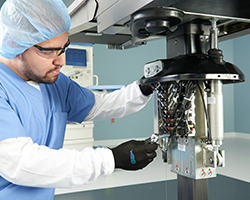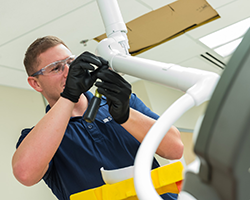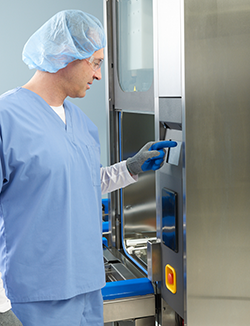Knowledge Center
January 12, 2021
Medical Equipment Compliance

Medical Equipment Compliance occurs when healthcare organizations complete all planned preventive maintenance activities on medical equipment on time. This can be achieved in one of two ways. The healthcare organization can be:
- 100% compliant with the Original Equipment Manufacturer (OEM) recommendations or
- 100% compliant with the policy set by their organization’s Alternative Equipment Maintenance (AEM) program
This article covers:
- Why is Medical Equipment Compliance important?
- What is The Joint Commission (TJC)?
- The Joint Commission Accreditation Process: Preparation, Application, Initial Survey, Decision, Promotion, and Continuous Improvement
- Joint Commission Standard: Management of the Environment of Care
- Performance Measurements
- Health Care Benchmarks
Why is Medical Equipment Compliance important?

Medical Equipment Compliance is important for a few reasons. First, it helps to ensure the equipment operates at maximum uptime with minimized, unscheduled downtime visits. Well-maintained equipment helps keep patient safety top of mind. Secondly, Medical Equipment Compliance is important due to maintaining The Joint Commission accreditation. In 2017, The Joint Commission mandated that 100% compliance is required for all types of medical equipment regardless of risk. This Joint Commission standard covers non-high risk to high risk equipment. During the Joint Commission surveys, healthcare organizations need to show documentation to confirm Medical Equipment Compliance.
The Joint Commission
The Joint Commission was founded in 1951 as an independent, non-profit organization. Its mission is to “continuously improve health care for the public, in collaboration with other stakeholders, by evaluating healthcare organizations and inspiring them to excel in providing safe and effective care of the highest quality and value.1” The Joint Commission provides accreditation for hospitals, home care facilities, nursing care centers, behavioral healthcare facilities, ambulatory care facilities, and laboratory services, which corresponds to +22,000 health care organizations in the United States.2 Only a healthcare organization located within the United States or operated by the United States can be accredited by The Joint Commission. After completing a successful survey, a health care organization receives The Gold Seal of Approval™ from The Joint Commission. Some payers require a healthcare organization to be accredited by The Joint Commission to be eligible for reimbursement. The Centers for Medicare and Medicaid Services (CMS) considers The Joint Commission as one candidate of approved and accredited organizations. The Joint Commission accreditation shows the healthcare organization has a framework that focuses on patient safety. The Joint Commission is well-regarded, since it is a long-standing, well-known organization.
The Joint Commission Accreditation Process: Preparation, Application, Initial Survey, Decision, Promotion, and Continuous Improvement

Preparation for The Joint Commission Survey should begin well in advance of a formal application. First, a healthcare organization should obtain the Comprehensive Accreditation Manual for Hospitals (CAMH). Then, it should organize a cross-functional, internal team and perform a self-assessment. Organizations should stay current of standards by monitoring www.jointcommission.org, attending seminars, and reviewing publications. Healthcare organizations should ensure these standards are implemented. Some organizations even conduct “mock surveys” to help them prepare. In addition, healthcare organizations should show compliance with National Patient Safety Goals (NPSGs), which are established by The Joint Commission.
After a healthcare organization has prepared to pass a survey, then it should formally apply. Formally applying means the healthcare organization applies and pays a deposit fee.
Once the application has been accepted by The Joint Commission, then preparation for the Initial Survey begins for both groups. The Joint Commission will assign an account executive that will act as a liaison. In addition, The Joint Commission assembles a team of surveyors and schedules an Initial Survey. The healthcare organization will continue to prepare for the Initial Survey. The healthcare organization should also advise the public that any individuals can report any complaints to The Joint Commission. The Initial Survey is scheduled within 12 months after formal application and is unannounced.
The on-site Initial Survey begins with Tracer Methodology. This is where current patients and recently discharged patients are traced amongst different areas within the healthcare organization and hand-offs are analyzed. The individuals’ experiences are reviewed to get an overall perspective of the healthcare organization system. In addition, key personnel interviews are conducted, documentation is examined, and physical facilities/equipment are appraised. The survey duration depends on the size and complexity of the healthcare organization.
After the on-site Initial Survey concludes, a report is provided by The Joint Commission. If TJC finds non-compliance with an Element of Performance (EP), then a Requirement for Improvement (RFI) is given. Any RFI needs to be corrected with evidence within 45 or 60 days. At that time, a healthcare organization can be given one of three statuses: Accredited, Accreditation with Follow-Up Survey or Preliminary Denial of Accreditation. Accredited means a healthcare organization has received The Joint Commission’s accreditation for 3 years. It is important to note once a health care organization has received its accreditation, this approval can be found on www.qualitycheck.org. Accreditation with Follow-Up Survey means an additional survey needs to be conducted within 30 days to six months, since the health care organization was found to be non-compliant with specific standards. A Preliminary Denial of Accreditation means the health care organization posed a threat to patient safety or there was significant non-compliance. A Preliminary Denial of Accreditation can be appealed. If an appeal is denied, then the healthcare organization will be given a Final Denial of Accreditation.

After a healthcare organization has received its accreditation, a publicity kit is available. The publicity kit contains sample news releases, fact sheets, guidelines, and The Gold Seal of Approval™ artwork.
A healthcare organization is expected to engage in continuous improvement activities post-accreditation. It should conduct on-going self-assessments. In addition, the healthcare organization needs to stay current as standards change, and it should also continually inform the public that any complaints should be reported to The Joint Commission. A Resurvey can be conducted 18-36 months after the previous survey. It is also important to note 5% of newly accredited healthcare organizations can have an Evidence of Standard Compliance (ESC) Validation Survey. This is done to ensure any corrective actions have been maintained. As with all surveys, the Resurveys and ESC surveys are unannounced.
The Joint Commission has been conducting unannounced surveys since January 2006. They do this because it ensures a better representation of the healthcare organization under normal conditions. It also alleviates any public concerns that the findings could be inaccurate or biased.
The Joint Commission Standard:
Management of the Environment of Care
The Comprehensive Accreditation Manual for Hospitals (CAMH) contains both patient-focused and organization standards. Medical Equipment Maintenance Programs and associated documentation primarily fall under the Management of the Environment of Care, which is an organization standard. “This standard promotes a safe, functional, and supportive environment within the hospital so that quality and safety are preserved.”1 However, there are elements of Medical Equipment Maintenance Programs that could fall under other standards, such as Infection Prevention and Control, Leadership, etc.
Performance Measurements
The Joint Commission handles performance measurement requirements through the ORYX® Initiative. This is a requirement for health care organizations to provide data prior to accreditation. Health care organizations have the flexibility to choose which measures they would like to provide data. These measures can be found on www.jointcommission.org.
Healthcare Benchmarks
The Joint Commission standards are a result of continual and constant analysis of the healthcare field to keep up with changes. A panel advises The Joint Commission regarding standards that should be considered for healthcare organizational compliance. These recommendations form the National Patient Safety Goals (NPSGs). The NPSGs generally involve issues that could cause serious patient harm, are widespread, are preventable, and there is a benefit of highlighting the issue.
Conclusion
Medical Equipment Compliance occurs when healthcare organizations complete all planned preventive maintenance activities on medical equipment on time. Medical Equipment Compliance is important for a few reasons. First, it helps to ensure equipment operates at maximum uptime with minimized unscheduled downtime visits. Secondly, Medical Equipment Compliance is important to be compliant with The Joint Commission standards. In 2017, The Joint Commission (TJC) mandated that 100% compliance is required for all types of medical equipment regardless of risk. To be compliant, one of the following two types of preventive maintenance needs to be followed:
- 100% compliant with the Original Equipment Manufacturer (OEM) recommendations or
- 100% compliant with the policy set by their organization’s Alternative Equipment Maintenance (AEM) program
In summary, The Joint Commission is an independent, non-profit organization that provides accreditation for healthcare organizations. Medical Equipment Compliance is both essential and required for your healthcare organization.
Learn about STERIS Service Solutions for Medical Equipment Compliance
References
1 The Joint Commission: Accreditation Guide for Hospitals 11/2017


